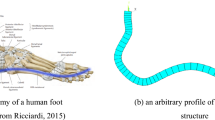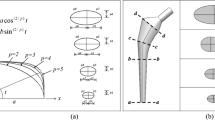Abstract
The longevity of the hip implants has been a major issue in recent times due to inadequate material used for implants. Since the metal on polymer implants has issues such as tissue degeneration and osteolysis, the focus of this study is to improve the tribological properties of ultra-high molecular-weight polyethylene (UHMWPE) which has been in use on acetabular cup of hip implants by considering multiple nanoparticles like carbon fibre, carbon nanotubes and graphene as reinforcements. It is extremely difficult and time-consuming through numerous experimental trials to arrive at the optimum material composition of nanoparticles. Therefore, an effort has been made on develo** a new polymer nanocomposite by utilizing the artificial intelligence (AI)-based design which includes the techniques, viz. artificial neural network (ANN) and genetic algorithm (GA). The input parameters like weight fraction and the geometry of the different nanoparticles related to the tribological properties were collected from various published literatures, and modelling was done through ANN for the output parameters, viz. coefficient of friction and specific wear rate. Best ANN predictive model was chosen individually for each output parameters on iterating the different hidden nodes. The fundamental correlation between the input and output parameters was investigated through sensitivity analysis. Optimization studies were performed using genetic algorithm (GA) with the best-chosen ANN model as an input to get optimum input variables. Thus, the AI-based approach of designing the UHMWPE nanocomposites shows an enhancement on the tribological properties that pave a way for further experimental trials.
Access this chapter
Tax calculation will be finalised at checkout
Purchases are for personal use only
Similar content being viewed by others
References
Campbell P, Beaulé PE, Ebramzadeh E, Leduff M, De Smet K, Lu Z, Amstutz HC (2006) The John Charnley Award: a study of implant failure in metal-on-metal surface arthroplasties. Clin Orthop Relat Res 453:35–46
Affatato S, Ruggiero A, Merola M (2015) Advanced biomaterials in hip joint arthroplasty. A review on polymer and ceramics composites as alternative bearings. Compos Part B Eng 83:276–283
Mikić Z, Lesić AR (2013) 50 years of total hip prosthesis—a tribute to Prof. Sir John Charnley. Acta Chir Iugosl 60(1):9–13
Blumm J, Lindemann A, Meyer M, Strasser C (2010) Characterization of PTFE using advanced thermal analysis techniques. International Journal of Thermophysics 31(10):1919–1927
Mano JF, Sousa RA, Boesel LF, Neves NM, Reis RL (2004) Bioinert, biodegradable and injectable polymeric matrix composites for hard tissue replacement: State of the art and recent developments. Compos Sci Technol 64(6):789–817
Vadivel HS, Golchin A, Emami N (2018) Tribological behaviour of carbon filled hybrid UHMWPE composites in water. Tribol Int 124:169–177
Datta S, Chattopadhyay PP (2013) Soft computing techniques in advancement of structural metals. Int Mater Rev 58(8):475–504
Sinha A, Sikdar Dey S, Chattopadhyay PP, Datta S (2013) Optimization of mechanical property and shape recovery behavior of Ti-(∼49 at.%) Ni alloy using artificial neural network and genetic algorithm. Mater Des 46:227–234
Bleck W, Sikdar Dey S, Bhattacharjee D, Bhattacharyya T, Brat Singh S, Bhattacharyya S (2012) Microstructural prediction through artificial neural network (ANN) for development of transformation induced plasticity (TRIP) aided steel. Mater Sci Eng A 565:148–157
Mohanty I, Bhattacharjee D, Datta S (2011) Designing cold rolled if steel sheets with optimized tensile properties using ANN and GA. Comput Mater Sci 50(8):2331–2337
Bin Ali A, Abdul Samad M, Merah N (2017) UHMWPE hybrid nanocomposites for Improved Tribological Performance Under Dry and Water-Lubricated Sliding Conditions. Tribol Lett 65(3):1–10
Naresh Kumar N, Yap SL, Samsudin B, Dayana FN, Khan MZ, Srinivasa P, Sreekanth R (2016) Effect of argon plasma treatment on tribological properties of UHMWPE/MWCNT nanocomposites. Polymers (Basel) 8(8):295
Manoj Kumar R, Sharma SK, Manoj Kumar BV, Lahiri D (2015) Effects of carbon nanotube aspect ratio on strengthening and tribological behavior of ultra high molecular weight polyethylene composite. Compos Part A Appl Sci Manuf 76:62–72
Liu B, Qi Y, Yan X, An Y, Pei J, Xue Q, Tai Z (2013) Friction and wear properties of graphene oxide/ultrahigh-molecular-weight polyethylene composites under the lubrication of deionized water and normal saline solution. J Appl Polym Sci 131(1):1–11
Tai Z, Chen Y, An Y, Yan X, Xue Q (2012) Tribological behavior of UHMWPE reinforced with graphene oxide nanosheets. Tribol Lett 46(1):55–63
Chukov DI, Stepashkin AA, Maksimkin AV, Tcherdyntsev VV, Kaloshkin SD, Kuskov KV, Bugakov VI (2015) Investigation of structure, mechanical and tribological properties of short carbon fiber reinforced UHMWPE-matrix composites. Compos Part B Eng 76:79–88
Tenison N, Baena JC, Yu J, Peng ZX (2017) Development of Mixing Methods of UHMWPE/Carbon Nanotubes (CNT) Composites for Use in Artificial Joints. Key Eng Mater 739:81–86
Zoo YS, An JW, Lim DP, Lim DS (2004) Effect of carbon nanotube addition on tribological behavior of UHMWPE. Tribol Lett 16(4):305–310
Rocha LA, Kanagaraj S, Oliveira MS, Simoes JA, Mathew MT, Fonseca A (2010) Tribological characterisation of carbon nanotubes/ultrahigh molecular weight polyethylene composites: the effect of sliding distance. Int J Surf Sci Eng 4(4–6):305–321
Baena JC, Peng Z (2018) Dispersion state of multi-walled carbon nanotubes in the UHMWPE matrix: effects on the tribological and mechanical response. Polym Test 71:125–136
Golchin A, Wikner A, Emami N (2016) An investigation into tribological behaviour of multi-walled carbon nanotube/graphene oxide reinforced UHMWPE in water lubricated contacts. Tribol Int 95:156–161
Sreekanth PSR, Kanagaraj S (2015) Influence of multi walled carbon nanotubes reinforcement and gamma irradiation on the wear behaviour of UHMWPE. Wear 334–335:82–90
Wang Y, Yin Z, Li H, Gao G, Zhang X (2017) Friction and wear characteristics of ultrahigh molecular weight polyethylene (UHMWPE) composites containing glass fibers and carbon fibers under dry and water-lubricated conditions. Wear 380–381:42–51
Lee JH, Kathi J, Rhee KY, Lee JH (2010) Wear properties of 3-aminopropyltriethoxysilane-functionalized carbon nanotubes reinforced ultra high molecular weight polyethylene nanocomposites. Polym Eng Sci 50(7):1433–1439
Olden JD, Joy MK, Death RG (2004) An accurate comparison of methods for quantifying variable importance in artificial neural networks using simulated data. Ecol Model 178:389–397
Datta S (2016) Materials design using computational intelligence techniques. CRC Press, UK
Mathworks C (2016) Global optimization toolbox user’s guide R 2016 b
Author information
Authors and Affiliations
Corresponding author
Editor information
Editors and Affiliations
Rights and permissions
Copyright information
© 2021 Springer Nature Singapore Pte Ltd.
About this paper
Cite this paper
Vinoth, A., Nirmal, K.N., Khedar, R., Datta, S. (2021). Optimizing the Tribological Properties of UHMWPE Nanocomposites—An Artificial Intelligence based approach. In: Akinlabi, E., Ramkumar, P., Selvaraj, M. (eds) Trends in Mechanical and Biomedical Design. Lecture Notes in Mechanical Engineering. Springer, Singapore. https://doi.org/10.1007/978-981-15-4488-0_70
Download citation
DOI: https://doi.org/10.1007/978-981-15-4488-0_70
Published:
Publisher Name: Springer, Singapore
Print ISBN: 978-981-15-4487-3
Online ISBN: 978-981-15-4488-0
eBook Packages: EngineeringEngineering (R0)




